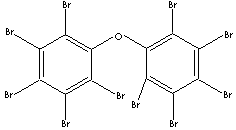DECABROMOBIPHENYL ETHER
PRODUCT IDENTIFICATION
1163-19-5

214-604-9
959.17
H.S. CODE
TOXICITY
CLASSIFICATION
Flame retardant, Phenol ether
CLASSIFICATION
TSCA Flag T [Subject to the Section 4 test rule under TSCA]
PHYSICAL AND CHEMICAL PROPERTIES
white powder
SOLVENT SOLUBILITY
AUTOIGNITION
NFPA RATINGS
Health: 1 Flammability: 0 Reactivity: 0
REFRACTIVE INDEX
EXTERNAL LINKS & GENERAL DESCRIPTION
http://www2.mst.dk/
Deca-BDE
and Alternatives in Electrical and Electronic Equipment
http://www.acsh.org/
AMERICAN
COUNCIL ON SCIENCE AND HEALTH - Brominated Flame Retardants:A Burning
Issue
http://www.nicnas.gov.au/
SUMMARY
REPORT FOR POLYBROMINATED FLAME RETARDANTS
Local: Decabromodiphenyl Oxide, belongs to a family of polybrominated flame retardant, is used polyolefins, styrenics, polyamides and thermoplastic polyester resins. Its end applications include elastomers, wire & cable, textile coatings, electrical & electronic equipments, automotive parts, construction materials, textile backcoatings and textile blends.
GENERAL DESCRIPTION OF FLAME RETARDANT AGENT: Flame Retardants are substances that can be chemically inserted into the polymer molecule or be phisically blended in polymers after polymerization to suppress, reduce, delay or modify the propagation of a flame through a plastic materials. There are several classes of flame retardants Halogenated Hydrocarbons (Chlorine and Bromine containing compounds and reactive flame retardants), Inorganic flame retardants ( Boron compounds, Antimony oxides, Aluminium Hydroxide, molybdenum compounds, zinc and magnesium oxides ), Phosphorous containing compounds (Organic phosphate esters, phosphates, halogenated phosphorus compounds and inorganic phosphorus containing salts).Class of Flame Retardants
- Inorganic
- Metal hydroxides
- Aluminium hydroxide
- Magnesium hydroxide
- Orthers
- Antimony compounds
- Antimony trioxide
- antimony pentoxide
- Sodium antimonate
- Others
- Boron compounds
- Boric acid
- Borax
- Zinc borate
- Others
- Other metal compounds
- Molybdenum compounds
- Titanium compounds
- Zirconium compounds
- Zinc compounds
- Zinc stannate
- Zinc hydroxy-stannate
- Others
- Others
- Phosphorus compounds
- Red phosphorus
- Ammonium polyphosphate
- Others
- Other inorganic flame retardants
- ammonium sulfamate
- ammonium bromide
- Others
- Halogenated organic
- Brominated
- Tetrabromobisphenol A
- Decabromodiphenyl ether
- Octabromobiphenyl ether
- Tetrabromobiphenyl ether
- Hexabromocyclododecane
- Tribromophenol
- Bis(tribromophenoxy) ethane
- Tetrabromobisphenol A polycarbonate oligomers
- Tetrabromobisphenol A epoxy oligomers
- Others
- Chlorinated
- Chlorinated paraffins
- Bis(hexachlorocyclopentadieno)cyclo-octane
- Others
- Organophosphoros
- Non-halogenated compounds
- phosphate esters
- Ttrialkyl phosphates
- Triaryl phosphates
- Aryl-alkyl phosphates
- Others
- polyols
- phosphonium derivatives
- phosphonates
- Others
- Halogenated phosphates
- Tris(1-chloro- 2-propyl) phosphate
- Tris(2-chloroethyl) phosphate
- Tris(2,3-dibromopropyl)phosphate
- Others
- Nitrogen-based
- Polyurethanes
- Polyamides
- Melamine and its salts
- Guanidine compounds
- Others
APPEARANCE
white powder
MELTING POINT
300 C min
Fe
10ppm
PARTICLE SIZE
5µ m max
Not regulated
SAFETY INFORMATION
PRICE INFORMATION